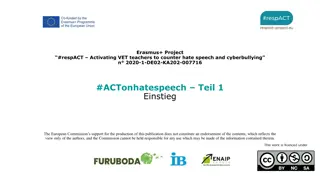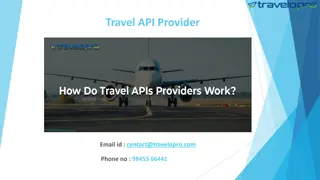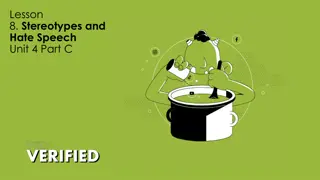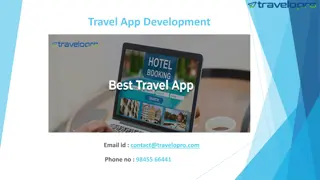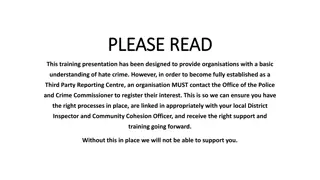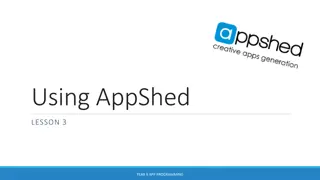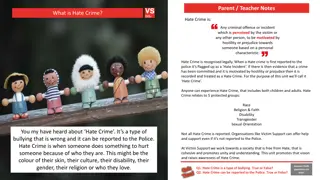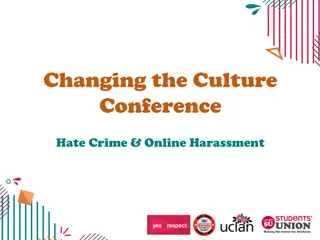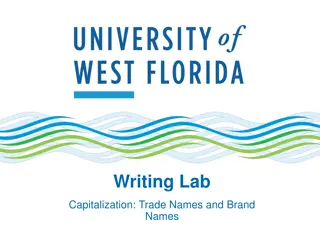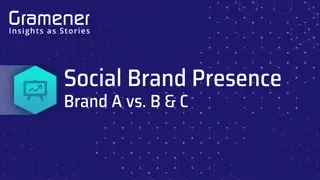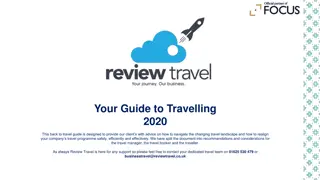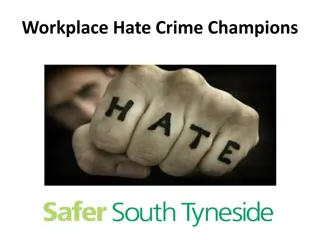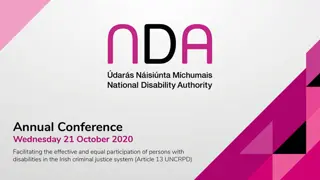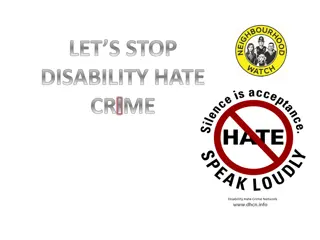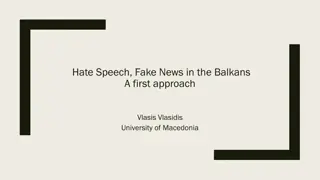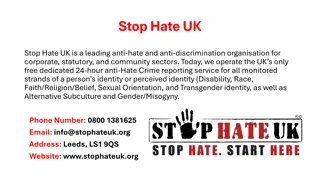Understanding Brand Hate in Travel Apps
Smart phone usage has surged globally, with a vast number of travel apps available for users. Despite this, retention rates remain low, indicating dissatisfaction among users. Research explores the concept of brand hate in the context of travel apps, examining antecedents and outcomes such as symbolic incongruity and brand retaliation. The study aims to shed light on why users may dislike or hate using travel apps, offering insights for improving brand relationships and user experiences.
Download Presentation

Please find below an Image/Link to download the presentation.
The content on the website is provided AS IS for your information and personal use only. It may not be sold, licensed, or shared on other websites without obtaining consent from the author. Download presentation by click this link. If you encounter any issues during the download, it is possible that the publisher has removed the file from their server.
E N D
Presentation Transcript
Determinates and outcomes of Brand Hate for Travel Apps Marc Fetscherin, Ph.D. Gelbman Family Chair of International Business Professor of Marketing Rollins College, USA 1
Background Smart phone usage is increasing 6 billion users globally 6 million apps available 218 billion apps download till 2020 Travel app Engagement Benchmark Reports (2021) 3-month retention rate for travel app was 29%, with a churn rate of 71% Moreover, according to Gupta et al. (2018) Annual travel App retention rate is 10%, with a churn rate of 90%. Only 15% of travelers use travel apps to plan their trips 2
Motivation Dissatisfaction with travel apps lead to why users don't like or hate using them Brand hate studied mostly physical products, wonder if also applicable to digital products Extend research by introducing Poor Brand Relationship Quality Extend research by decomposing nWOM into public and private complaining Measure Brand Hate by multi-dimensional scale from Zhang and Laroche (2020) Zhang, C., & Laroche, M. (2020). Brand hate: a multidimensional construct. Journal of Product & Brand Management, 30(3), 392-414. 3
Brand Hate Sternberg (2003) Kucuk's (2008) Bryson et al. (2013) Zarantonello et al. s (2016) Hegner et al. (2017) Fetscherin (2019) Zhang and Laroche (2020) Extensively studied in physical context but very limited study in the online context Since COVID, many brands morphed from brick & mortar to click & mortar Literature suggested that antecedents of brand hate can be categorized in product related, consumer related and market-company related Brand outcomes can be categorized based on passive behavior (taking a flight) and active behavior (taking a fight) strategy Different researchers have identified distinct antecedents and outcomes of brand hate based on their context 4
Hegner et al., (2017) Negative Past Experience Brand Avoidance Symbolic Incongruity Negative WOM Brand Hate (BH) Ideological Incompatibility Brand Retaliation Hegner, S. M., Fetscherin, M., & Van Delzen, M. (2017). Determinants and outcomes of brand hate. Journal of Product & Brand Management, Volume 26 Number 1 2017 13 25 5
Hypotheses Antecedents of Brand hate H1: Symbolic incongruity leads towards travel App hate H2: Ideological incompatibility leads towards travel App hate H3: Negative past experience leads towards travel App hate H4: Poor relationship quality leads towards travel App hate Outcomes of brand hate H5: Travel App hate leads towards app avoidance H6: Travel App hate leads towards patronage reduction H7: Travel App hate leads towards private complaining H8: Travel App hate leads towards public complaining 6
H4: Poor Brand Relationship Quality Poor relationship quality refers to customers' negative relationship with brands other than its actual performance, symbolic value or ideological incompatibility (Hashim and Kasana 2019) It is found that a positive relationship of brand and customer increase brand equity and loyalty while a negative relationship increases anxiety and anger in consumers (Lemon, Rust, and Zeithaml, 2001) Recently Hashim and Kasana (2019) found the significant relationship between poor relationship quality on brand hate in the fast-food industry 7
H7 & H8 Complaining Consumers are more interested in sharing their bad experiences than their good experiences, which generate negative WOM (Baumeister et al. 2001) Literature decompose negative WOM into at least two parts, complaining to family and friends (private complaining) and complaining more publicly or to third party organizations such as consumer agencies, legal institutes, and consumers firms (public complaining) (Fetscherin, 2019) 8
Brand Hate Use multi-dimensional scale based on anger, fear and sadness 9
Research Model & Hypotheses Symbolic Incongruity Brand Avoidance H1 H5 Ideological Incompatibility H2 H6 Private Complaining Travel App Brand Hate H7 H3 Indirect Vengeance Negative Past Experience Public Complaining H8 H4 Poor Brand Relationship Quality Patronage Reduction Direct Vengeance 10
Method Purposive (non-probability) sampling Online survey through traveling agencies 549 usable responses Two stage PLS-SEM Analysis Measurement Model analysis Loadings > 0.50 Composite Reliability > 0.70 AVE > 0.5 Correlation of two constructs < 0.9 11
Sample 12
Results Symbolic Incongruity (SYI) Brand Avoidance (BRA) .164*** .295*** Ideological Incompatibility (IDI) .324*** .496*** Travel App Brand Hate R2=.313 Private Complaining (PRC) .128*** .549*** Indirect Vengeance Negative Past Experience (NPE) Public Complaining (PUC) .533*** .100*** Poor Brand Relationship Quality (BRQ) Patronage Reduction (PAR) Direct Vengeance 13
Results All determinants lead towards brand hate and it leads to brand avoidance, patronage reduction, private complaining, and public complaining Among all determinants, ideological incompatibility has highest impact on consumers brand hate for travel apps It means unethical activities of brand or mismatch in ideology of the consumers with brand travel apps can lead to brand hate While brand relationship quality has lowest impact on brand hate It is found that consumers are most likely to be involved in attack-like activities, i.e. private complaining and a public complaining if the brand disappoints them badly 14
Theoretical Contribution The Study extended and deepened the brand hate model in the Travel app context The study adopted Zhang & Laroche (2020) multidimensional brand hate construct which was quite limited in the literature Previous researches mainly focused on the positive emotions, usage intention and adoption of the travel apps but this study extends previous ones by focusing on negative emotion of travel apps 15
Managerial Implications Managers have to ensure that the company would not involve any unethical or immoral activity Travel App developers should provide a set of activities in apps through which consumers consider how this brand is like them Positive experience and high relationship consistency are needed to prevent negative emotions in customers The research and development team should focus on two key attributes: App design and efficiency 16
Limitations and Future Research The study classified domestic and foreign travelers but didn t compare them. So future research can compare domestic and foreign travelers The study only focused on the brand hate for travel apps and ignored the reasons for brand love. So, Future research can test the determinants of brand love for travel apps 17
Thanks! Any Question? 18
Antecedents of Brand Hate Author (s) (year) Product-related Consumer-related Market/ Company-related Other (Krishnamurthy and Kucuk 2009b) Transactional dissatisfaction (with retailer and quality of service) Market-level dissatisfaction Ideological incompatibility (Kucuk 2016a) Transactional (dissatisfaction related to product failure) Ideological (related to social change) Consumer personality issues Market-industry (related to irresponsible practices) (Zarantonello et al. 2016) Violations of expectations Taste systems Corporate wrongdoings (Hegner, Fetscherin, and Delzen 2017) Negative past experience Symbolic incongruity Ideological incompatibility (Kucuk 2018) Product or Service failure Corporate social responsibility (Zarantonello et al. 2018) Negative past experience Image incongruence Corporate wrongdoings (Hashim and Kasana 2019) Negative past experience Symbolic incongruity Ideological incompatibility Rumour Poor Relationship Quality 19
Outcome of Brand Hate Take a flight (passive behavior) Take a fight (active behavior) Author(s) year Brand Avoidance/Switching Private complaining Public Complaining (Kucuk 2016a) Negative word of mouth Complaining Consumer boycott (Zarantonello et al. 2016) Patronage reduction Negative word of mouth Complaining Protest (Hegner, Fetscherin, and Delzen 2017) Brand Avoidance Negative word of mouth Brand retaliation (Fetscherin 2019) Brand Switching Private Complaining Public Complaining Retaliation Brand Avoidance Negative word of mouth Online Complaining (Curina et al. 2019) (Zhang and Laroche 2020) Patronage reduction Negative WOM Complaint Protest Non-purchase intention Offline NWOM Online Complaining (Curina et al. 2020) (Bayarassou, Becheur, and Valette-Florence 2020) Avoidance Revenge 20
Results and Analysis R2 F2 Q2 Hypotheses VIF Support ed Beta Values STD T Statistics P Values H1: SYI BH 1.560 0313 0.027 0.142 0.164 0.058 2.860 0.002 H2: IDI BH 1.303 0.080 0.324 0.064 5.067 0.000 H3: NPE BH 1.456 0.015 0.128 0.063 2.032 0.021 H4: BRQ BH 1.894 0.011 0.100 0.054 1.856 0.032 H5: BH BRA 1.000 0.095 0.295 0.048 6.150 0.000 H6: BH PAR 1.000 0.396 0.496 0.041 11.993 0.000 H7: BH PRC 1.000 0.431 0.549 0.043 12.709 0.000 H8: BH PUC 1.000 0.396 0.533 0.045 11.911 0.000 21
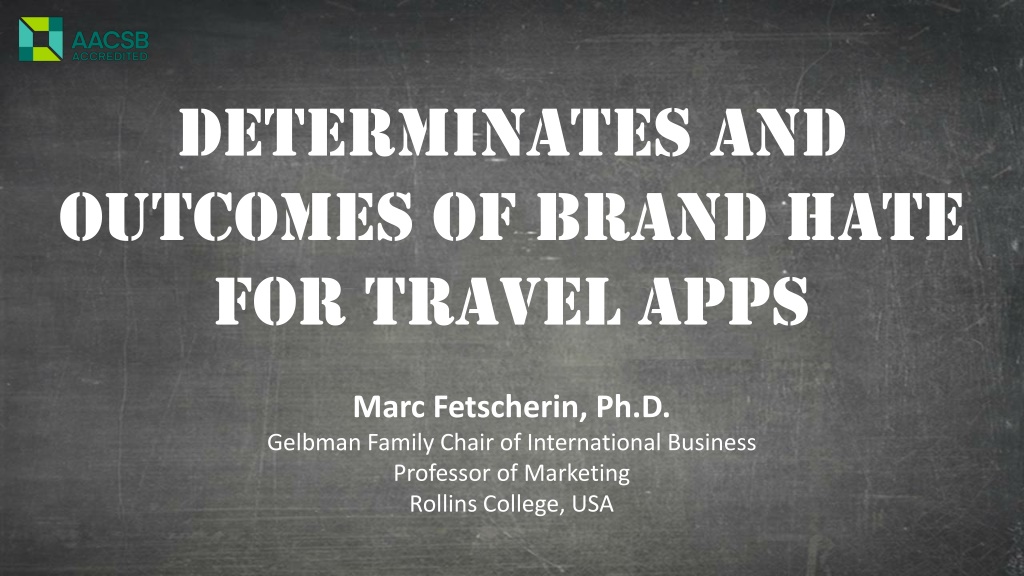

![Prevention and Combating of Hate Crimes and Hate Speech Bill [B.9B.2018]](/thumb/60513/prevention-and-combating-of-hate-crimes-and-hate-speech-bill-b-9b-2018.jpg)
